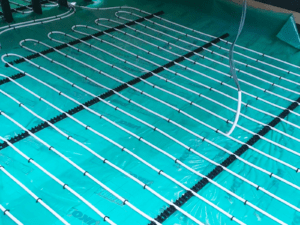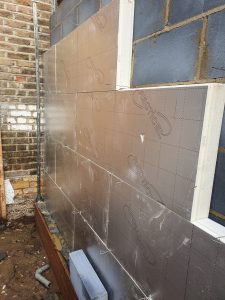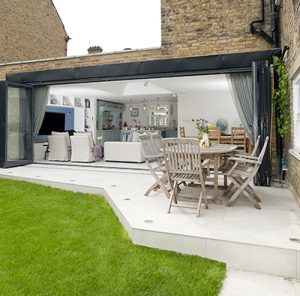With winter already on the horizon, what better time to explore the best options for heating your home extension. As the UK heads into another winter with rising energy costs, tighter building regulations and an accelerating shift toward low-carbon living, heating your extension efficiently is more important than ever. The government’s commitment to net zero emissions by 2050 means that homeowners play a key role in reducing carbon emissions – starting with smart heating choices.
Whether you’re building a new extension or upgrading an old one, planning an eco-friendly solution or the latest in modern technology, here are the most up-to-date, cost-effective and sustainable ways to heat your space.
01 – Upgrade to a High-Efficiency or Hybrid Boiler
A good starting point is to assess whether your existing boiler can handle the increased heating demands your extension will pose. Older boilers are often less efficient and may struggle to heat larger spaces effectively. Upgrading to a hydrogen-ready or ErP A-rated boiler will ensure that your heating system is future-proof and energy-efficient.
Hybrid systems, which combine a boiler with a heat pump, offer excellent efficiency for UK winters. Depending on your location and income, you may qualify for ECO4 or Boiler Upgrade Scheme grants. Efficient boilers lower energy bills and carbon emissions and meet with 2025 standards.
02 – Upgrade Glazing for Better Heat Retention
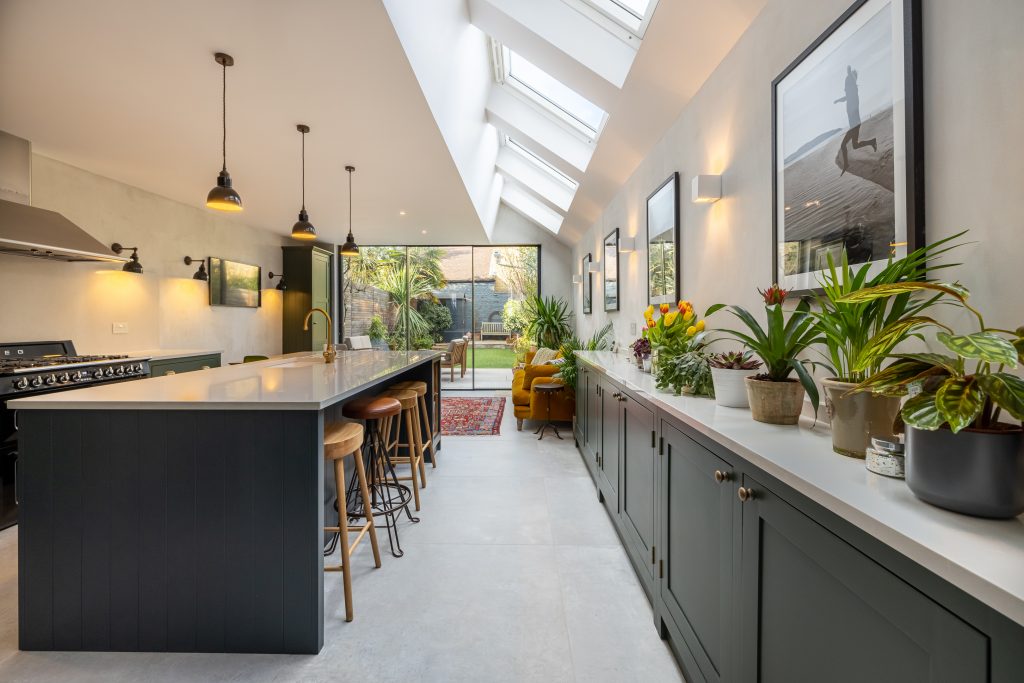
Windows and doors play a crucial role in how well a room retains heat. Poor quality glazing can lead to significant heat loss – and this will force your heating system to work harder. Opt for quadruple glazing or vacuum-insulated glass for maximum performance.
Low-emissivity (low-E) glass is another excellent option. This type of glass has a special coating that reflects heat back into the room while still allowing natural light to enter. This will keep your extension warm in winter and cooler in summer – reducing the need for heating and air conditioning systems.
For large glazed areas, consider solar control glass or dynamic smart glazing. When choosing glass, aim for U-values less than 1.2 W/m²K to comply with 2025 Building Regulations Part L.
03 – Install Water-Based Underfloor Heating (UFH)
Underfloor heating is a popular choice for extensions. This system provides an even distribution of heat, as it warms the room from the ground up, making it very effective in larger spaces like open-plan kitchen and living areas. Underfloor heating is now commonly installed alongside air source heat pumps, making it both comfortable and efficient.
There are two main types of underfloor heating: electric and water-based systems. Electric systems are easier to install, especially in smaller spaces, but they can be more expensive to run in the long-term. Water-based systems (UFH) are more energy-efficient in the long run and work well when connected to a high-efficiency boiler or heat pump.
Underfloor heating offer a comfortable, radiant warmth, but has the major advantage of reducing dust circulation – making it a good choice for allergy sufferers. Under floor heating systems can be can be integrated with smart thermostats for greater control over the heating schedule and energy use. Zoned control and room-by-room scheduling are both standard in 2025.
For better performance ensure compliance with 150mm rigid foam floor insulation under screed floors as this will deliver even warmth, low operating costs, and excellent compatibility with low-carbon systems.
04 – Use Smart Thermostats to Optimise Energy Use
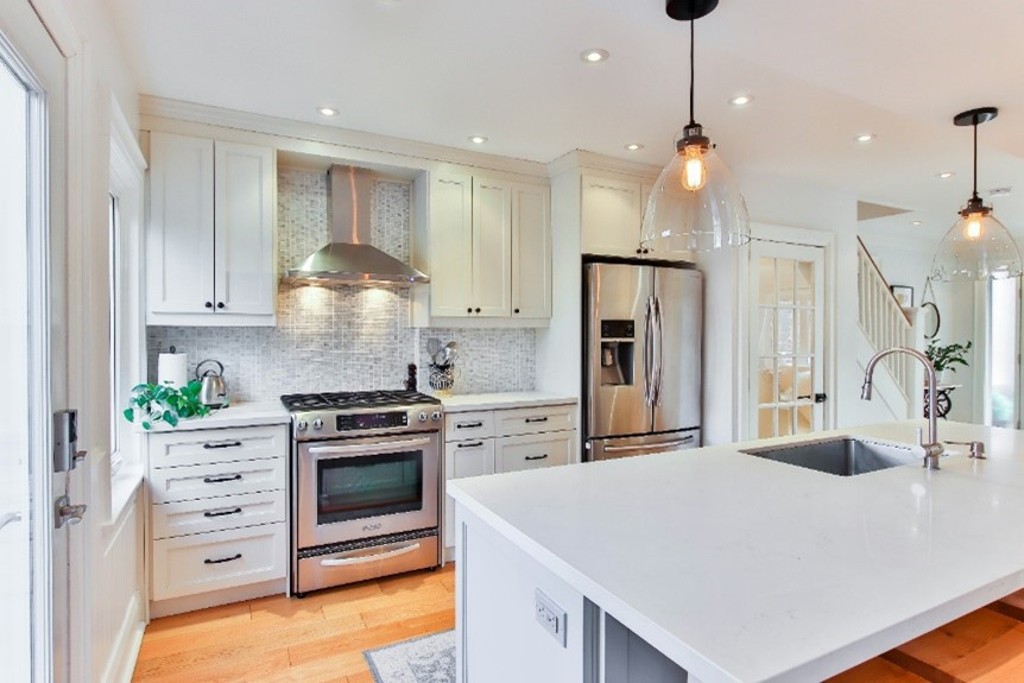
To maximise the efficiency of your heating system now you have a new extension, consider installing smart thermostats such as Tado, Hive, Nest, Heatmiser and Neo. These devices allow you to control your heating remotely via your smartphone, ensuring that your home is always at the perfect temperature when you need it.
Smart thermostats can learn your daily schedule and adjust heating accordingly. This helps to save energy by only heating rooms when necessary. 2025 models include AI learning, occupancy detection and multi-zone controls.
Many integrate with solar systems and battery storage for off-grid efficiency and some integrate with weather forecasts to make real-time adjustments based on outdoor conditions. All of these features help to improve your home’s energy efficiency and cut bills by up to 20%.
05 – Choose Low-Carbon Heating Systems
In 2025, sustainability is a key priority for homeowners. There are now a variety of eco-friendly heating options that can reduce your carbon footprint while keeping your new extension warm.
One popular choice is biomass boilers, which burn organic materials like wood pellets to generate heat. While this system requires regular maintenance and storage for fuel, it offers a more sustainable alternative to traditional gas or oil boilers.
Other options include infrared panels for spaces with limited plumbing and solar-assisted heat pumps and solar PV integration for energy independence. All contribute to SAP rating improvements for new builds and extensions and bring many benefits, including lower emissions, high efficiency, and eligibility for retrofit incentives.
06 – Install Efficient Radiators and Zoned Heating
If underfloor heating will not work in your extension, upgrading or adding energy-efficient radiators is a great alternative. Modern radiators come in a variety of styles and sizes and it is best to choose low water radiators or aluminium radiators.
To ensure maximum efficiency, use smart zoning via home energy apps for areas like open-plan kitchens or dual-use spaces. This approach allows you to heat different areas of your home independently, ensuring that you’re only using energy where it’s needed.
The benefit is that the required space will warm up quicker, you will have more control and the result will be better energy savings.
07 – Opt for an Air Source Heat Pump
Air source heat pumps (ASHPs) are among the most popular heating options in 2025 and a great way to future-proof your new extension. These systems extract heat from the outside air or ground and transfer it into your home, providing an eco-friendly and energy-efficient way to heat your space.
There are two main types of heat pump: air-source and ground-source heat pumps. Air-source heat pumps are easier to install and work well in most climates, while ground-source systems are more efficient but require more space for installation.
Heat pumps are highly efficient and can significantly reduce your reliance on traditional heating systems, lowering your energy bills and carbon emissions. Newer models perform efficiently even in low temperatures and work particularly well with underfloor heating or modern radiators. MCS certification is essential to access government grants and ensure quality installation.
08 – Maximise Insulation for a Strong Thermal Envelope
No matter how efficient your heating system is, it won’t be effective without proper insulation. Don’t overlook insulation as it is fundamental for comfort and energy savings. Ensuring your home extension is well insulated will prevent heat loss and help stabilise the temperature in your extension – keeping the space warm in winter and cool in summer.
Good insulation is essential for the walls, roof, and floors of your extension to minimise heat escaping. Cavity wall insulation and loft insulation are both excellent options that can significantly reduce energy consumption and lower your heating bills. Floor insulation is particularly important if you’re installing underfloor heating, as it prevents heat from escaping downwards.
Good insulation is a long-term investment that will pay off by making your extension more comfortable and energy-efficient all year round.
Use natural and recycled materials like wood fibre, cellulose, and sheep wool. Include airtightness membranes and blower door testing to prevent heat loss. Upgrade floors with mineral wool between joists or rigid board under concrete slabs. Taking these steps will reduce heat loss, improve comfort and increase the energy efficiency of your extension.
Common Mistakes to Avoid
Here are some common mistakes to avoid when heating your space:
- Don’t under-size your heating system—calculate requirements based on the accurate assessment of heat demand.
- Skipping floor insulation with UFH drastically reduces efficiency.
- Ignoring air tightness leads to draughts and higher bills
Choosing the right heating strategy for your extension means balancing efficiency, comfort, and sustainability. With a wide range of grants, improved materials, and smarter tech, there’s never been a better time to upgrade.
There are many options available to suit different needs, budgets and environmental goals. Some choices like low-carbon heating now increase property value, future-proof your home and help meet upcoming energy standards.
By taking the time to choose the right heating system for your extension, you’ll ensure that your new space is comfortable, sustainable and importantly, cost-effective for years to come. Planning on making some changes? Need some advice? Get in touch with Build Team today.


